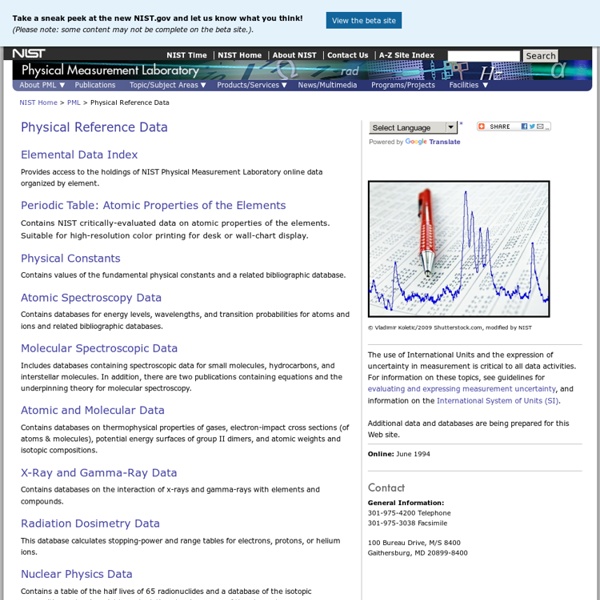Physical Reference Data
Elemental Data Index Provides access to the holdings of NIST Physical Measurement Laboratory online data organized by element. Periodic Table: Atomic Properties of the Elements Contains NIST critically-evaluated data on atomic properties of the elements. Suitable for high-resolution color printing for desk or wall-chart display. Contains values of the fundamental physical constants and a related bibliographic database. Contains databases for energy levels, wavelengths, and transition probabilities for atoms and ions and related bibliographic databases. Includes databases containing spectroscopic data for small molecules, hydrocarbons, and interstellar molecules. Contains databases on thermophysical properties of gases, electron-impact cross sections (of atoms & molecules), potential energy surfaces of group II dimers, and atomic weights and isotopic compositions. Contains databases on the interaction of x-rays and gamma-rays with elements and compounds.
Encrypt your files with a drop
Computer Glossary, Computer Terms - Technology Definitions and Cheat Sheets from WhatIs.com - The Tech Dictionary and IT Encyclopedia
Top Stories How to research enterprise tech purchases Conquering the tech buying landscape can be challenging. Pros and cons of facial recognition While facial recognition can offer many security and authentication benefits, flawed or misused facial recognition systems can put consumers at risk. 18 companies on stock exchange innovating in AI Keep an eye on the AI innovators as the turbulent AI industry evolves. 34 AI content generators to explore in 2024 Artificially generated media continues to progress. View All Learning Content Browse Definitions By Topic In-Depth Guides What is data governance and why does it matter? New & Updated Definitions Tech News Getty Images/iStockphoto Microsoft allies with OpenAI rival Mistral AI Broadcom to sell VMware EUC division to KKR for $3.8B Customers that pair VMware's hypervisor with Horizon and Workspace One desktops might feel licensing jitters, but the deal could lead to more ... New merger guidelines, crackdown affect business strategies Close
Differences between viewing light and dark explain old optical illusion | National Academy of Sciences
Astronomers and physicists starting with Galileo noticed centuries ago that when one looks at celestial objects — bright objects on a dark background — they appear to be too large. Now scientists have discovered the brain mechanisms underlying this effect. The findings are reported in the Proceedings of the National Academy of Sciences. Galileo was puzzled by how the appearance of the planets changed depending on whether one looked at them with the naked eye versus a telescope. Viewed directly, planets seemed “expanded” and had “a radiant crown,” which made Venus look larger than Jupiter, despite the fact that Jupiter was actually wider. Galileo’s assumption was that this illusion was due to light scattered from aberrations and other factors in the eye. The researchers suggest that, on dark backgrounds, the visual pathway increases sensitivity to detect the presence of a faint stimulus as best as possible, which compromises the ability to report the size of bright objects accurately.
Ultradox
FOLDOC - Computing Dictionary
Mind-controlling virus forces parasitic wasp to put all its eggs in one basket
Leptopilina boulardi by Alexander Wild In a French meadow, a creature that specialises in corrupting the bodies of other animals is getting a taste of its own medicine. Leptopilina boulardi is a wasp that lays its eggs in fly maggots. When the wasp grub hatches, it devours its host form the inside out, eventually bursting out of its dead husk. A maggot can only support a single grub, and if two eggs end up in the same host, the grubs will compete with one another until only one survives. Usually, but not always. L.boulardi is sometimes infected by a virus called LbFV, which stands for L.boulardi filamentous virus. The virus’s manipulation is extraordinarily specific. How does it do this? Julien Varaldi from the University of Lyon first discovered LbFV in 2003, and he has spent the last decade unveiling the quirks of its wasp-management ability. The same French countryside is home to a closely related wasp called Leptopilina heterotoma. Why? More on parasitic wasps:
Sitehoover
CSS Tutorial
Focused ultrasound modulates region-specific brai... [Neuroimage. 2011
Related:
Related:



